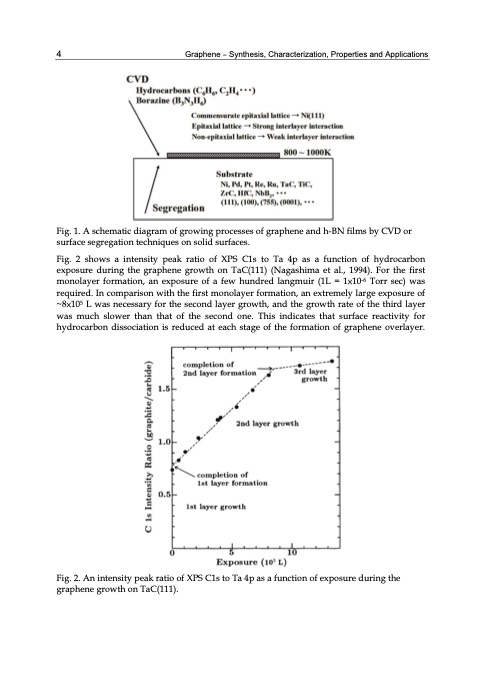
PDF Publication Title:
Text from PDF Page: 014
4 Graphene – Synthesis, Characterization, Properties and Applications Fig. 1. A schematic diagram of growing processes of graphene and h-BN films by CVD or surface segregation techniques on solid surfaces. Fig. 2 shows a intensity peak ratio of XPS C1s to Ta 4p as a function of hydrocarbon exposure during the graphene growth on TaC(111) (Nagashima et al., 1994). For the first monolayer formation, an exposure of a few hundred langmuir (1L = 1×10-6 Torr sec) was required. In comparison with the first monolayer formation, an extremely large exposure of ~8×105 L was necessary for the second layer growth, and the growth rate of the third layer was much slower than that of the second one. This indicates that surface reactivity for hydrocarbon dissociation is reduced at each stage of the formation of graphene overlayer. Fig. 2. An intensity peak ratio of XPS C1s to Ta 4p as a function of exposure during the graphene growth on TaC(111).PDF Image | GRAPHENE SYNTHESIS CHARACTERIZATION PROPERTIES

PDF Search Title:
GRAPHENE SYNTHESIS CHARACTERIZATION PROPERTIESOriginal File Name Searched:
Graphene-Synthesis.pdfDIY PDF Search: Google It | Yahoo | Bing
Salgenx Redox Flow Battery Technology: Power up your energy storage game with Salgenx Salt Water Battery. With its advanced technology, the flow battery provides reliable, scalable, and sustainable energy storage for utility-scale projects. Upgrade to a Salgenx flow battery today and take control of your energy future.
| CONTACT TEL: 608-238-6001 Email: greg@infinityturbine.com | RSS | AMP |